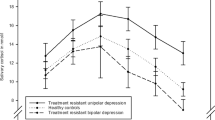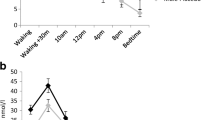Abstract
Rationale
It has been suggested that hypothalamic-pituitary-adrenocortical (HPA) system dysregulation plays an important role in the pathophysiology of depression and that normalization of HPA axis hyperactivity precedes successful treatment with antidepressants. Mirtazapine acts as an antagonist at presynaptic α2-receptors and at postsynaptic 5-hydroxytryptamine (5-HT)2, 5-HT3 and histamine H1 receptors. It has been shown acutely to inhibit cortisol secretion in healthy subjects.
Objective
In this study, we investigated whether mirtazapine may downtune HPA axis hyperactivity in depressed patients and whether this is related to treatment outcome.
Methods
Forty patients suffering from a major depressive episode (DSM-IV criteria) were treated with mirtazapine for 5 weeks. The combined dexamethasone suppression/CRH stimulation test (DEX/CRH test) was performed before and after 1 week of mirtazapine treatment (45 mg daily).
Results
Mirtazapine effectively reduced the overshoot of cortisol and ACTH during the DEX/CRH test both in treatment responders and non-responders within 1 week.
Conclusions
Apparently, mirtazapine rapidly attenuates HPA axis hyperactivity in depressed patients via direct pharmacoendocrinological effects. However, this amelioration of HPA system dysregulation is not necessarily related to clinical improvement.

Similar content being viewed by others
References
Arana GW, Baldessarini RJ, Ornsteen M (1985) The dexamethasone suppression test for diagnosis and prognosis in psychiatry. Arch Gen Psychiatry 42:1193–1204
Barden N, Reul JM, Holsboer F (1995) Do antidepressants stabilize mood through actions on the hypothalamic-pituitary-adrenocortical system? Trends Neurosci 18:6–11
Bech P (2001) Meta-analysis of placebo-controlled trials with mirtazapine using the core items of the Hamilton Depression Scale as evidence of a pure antidepressive effect in the short-term treatment of major depression. Int J Neuropsychopharmacol 4:337–345
Bech P, Gram LF, Dein E, Jacobsen O, Vitger J, Bolwig TG (1975) Quantitative rating of depressive states. Acta Psychiatr Scand 51:161–170
Bowie PC, Beaini AY (1985) Normalisation of the dexamethasone suppression test: a correlate of clinical improvement in primary depressives. Br J Psychiatry 147:30–35
Davis KL, Davis BM, Mathe AA, Mohs RC, Rothpearl AB, Levy MI, Gorman LK, Berger P (1984) Age and the dexamethasone suppression test in depression. Am J Psychiatry 141:872–874
De Boer T (1995) The effects of mirtazapine on central noradrenergic and serotonergic neurotransmission. Int Clin Psychopharmacol 10:19–23
Feinberg M, Carroll BJ (1984) Biological "markers" for endogenous depression. Effect of age, severity of illness, weight loss, and polarity. Arch Gen Psychiatry 41:1080–1085
Gerken A, Maier W, Holsboer F (1985) Weekly monitoring of dexamethasone suppression response in depression: its relationship to change of body weight and psychopathology. Psychoneuroendocrinology 10:261–271
Ghadirian AM, Engelsmann F, Dhar V, Filipini D, Keller R, Chouinard G, Murphy BE (1995) The psychotropic effects of inhibitors of steroid biosynthesis in depressed patients refractory to treatment. Biol Psychiatry 37:369–375
Golden RN, Hsiao J, Lane E, Hicks R, Rogers S, Potter WZ (1989) The effects of intravenous clomipramine on neurohormones in normal subjects. J Clin Endocrinol Metab 68:632–637
Greden F, Gardner R, King D, Grunhaus L, Carroll J, Kronfol Z (1983) Dexamethasone suppression test in antidepressant treatment of melancholia. Arch Gen Psychiatry 40:493–500
Hamilton M (1960) A rating scale for depression. J Neurol Neurosurg Psychiatry 23:56–62
Heuser IJ, Schweiger U, Gotthardt U, Schmider J, Lammers CH, Dettling M, Yassouridis A, Holsboer F (1996) Pituitary-adrenal-system regulation and psychopathology during amitriptyline treatment in elderly depressed patients and normal comparison subjects. Am J Psychiatry 153:93–99
Holsboer F (2000) The corticosteroid receptor hypothesis of depression. Neuropsychopharmacology 23:477–501
Holsboer F, Liebl R, Hofschuster E (1982) Repeated dexamethasone suppression test during depressive illness. Normalization of test result compared with clinical improvement. J Affect Disord 4:93–101
Hubain PP, Staner L, Dramaix M, Kerkhofs M, Papadimitriou G, Mendlewicz J, Linkowski P (1998) The dexamethasone suppression test and sleep electroencephalogram in nonbipolar major depressed inpatients: a multivariate analysis. Biol Psychiatry 43:220–209
Keitner GI, Brown WA, Qualls CB, Haier RJ, Barnes KT (1985) Results of the dexamethasone suppression test in psychiatric patients with and without weight loss. Am J Psychiatry 142:246–248
Laakmann G, Schüle C, Baghai T, Waldvogel E (1999) Effects of mirtazapine on growth hormone, prolactin, and cortisol secretion in healthy male subjects. Psychoneuroendocrinology 24:769–784
Mendlewicz J, Kerkhofs M, Hoffmann G, Linkowski P (1984) Dexamethasone suppression test and REM sleep in patients with major depressive disorder. Br J Psychiatry 145:383–388
Murphy BE, Dhar V, Ghadirian AM, Chouinard G, Keller R (1991) Response to steroid suppression in major depression resistant to antidepressant therapy. J Clin Psychopharmacol 11:121–126
Nutt D, Middleton H, Franklin M (1987) The neuroendocrine effects of oral imipramine. Psychoneuroendocrinology 12:367–375
O'Dwyer AM, Lightman SL, Marks MN, Checkley SA (1995) Treatment of major depression with metyrapone and hydrocortisone. J Affect Disord 33:123–128
Oxenkrug GF, Pomara N, McIntyre IM, Branconnier RJ, Stanley M, Gershon S (1983) Aging and cortisol resistance to suppression by dexamethasone: a positive correlation. Psychiatry Res 10:125–130
Petraglia F, Facchinetti F, Martignoni E, Nappi G, Volpe A, Genazzani AR (1984) Serotoninergic agonists increase plasma levels of beta-endorphin and beta-lipotropin in humans. J Clin Endocrinol Metab 59:1138–1142
Schüle C, Baghai T, Goy J, Bidlingmaier M, Strasburger C, Laakmann G (2002) The influence of mirtazapine on anterior pituitary hormone secretion in healthy male subjects. Psychopharmacology 163:95–101
Schweitzer I, Maguire KP, Gee AH, Tiller JW, Biddle N, Davies B (1987) Prediction of outcome in depressed patients by weekly monitoring with the dexamethasone suppression test. Br J Psychiatry 151:780–784
Sharma RP, Pandey GN, Janicak PG, Peterson J, Comaty JE, Davis JM (1988) The effect of diagnosis and age on the DST: a metaanalytic approach. Biol Psychiatry 24:555–568
Skene DJ, Bojkowski CJ, Arendt J (1994) Comparison of the effects of acute fluvoxamine and desipramine administration on melatonin and cortisol production in humans. Br J Clin Pharmacol 37:181–186
Stokes PE, Stoll PM, Koslow SH, Maas JW, Davis JM, Swann AC, Robins E (1984) Pretreatment DST and hypothalamic-pituitary-adrenocortical function in depressed patients and comparison groups. A multicenter study. Arch Gen Psychiatry 41:257–267
Thakore JH, Dinan TG (1995) Cortisol synthesis inhibition: a new treatment strategy for the clinical and endocrine manifestations of depression. Biol Psychiatry 37:364–368
Wolkowitz OM, Reus VI, Chan T, Manfredi F, Raum W, Johnson R, Canick J (1999) Antiglucocorticoid treatment of depression: double-blind ketoconazole. Biol Psychiatry 45:1070–1074
World Medical Association (2000) World Medical Association Declaration of Helsinki, ethical principles for medical research involving human subjects. Ferney-Voltaire, WMA, http://www.wma.net/e/policy/17-c_e.html
Acknowledgements
The authors wish to thank Angela Johnson and Beatrix Geissler for expert technical assistance. This study was supported by the German Ministry for Education and Research within the promotional emphasis "German Research Network on Depression", subproject 4.3.
Author information
Authors and Affiliations
Corresponding author
Rights and permissions
About this article
Cite this article
Schüle, C., Baghai, T., Zwanzger, P. et al. Attenuation of hypothalamic-pituitary-adrenocortical hyperactivity in depressed patients by mirtazapine. Psychopharmacology 166, 271–275 (2003). https://doi.org/10.1007/s00213-002-1356-z
Received:
Accepted:
Published:
Issue Date:
DOI: https://doi.org/10.1007/s00213-002-1356-z




